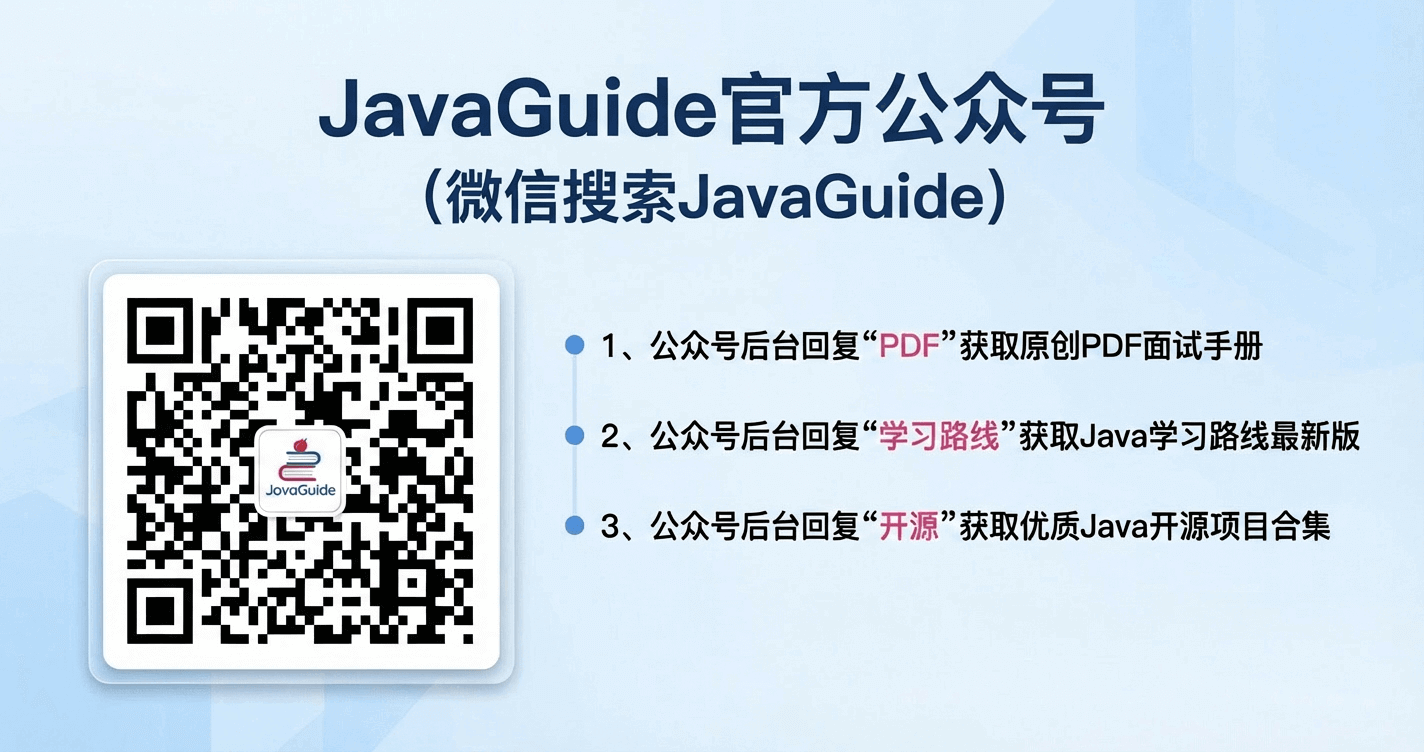Java IO 设计模式总结
这篇文章我们简单来看看我们从 IO 中能够学习到哪些设计模式的应用。
装饰器模式
装饰器(Decorator)模式 可以在不改变原有对象的情况下拓展其功能。
装饰器模式通过组合替代继承来扩展原始类的功能,在一些继承关系比较复杂的场景(IO 这一场景各种类的继承关系就比较复杂)更加实用。
对于字节流来说, FilterInputStream (对应输入流)和FilterOutputStream(对应输出流)是装饰器模式的核心,分别用于增强 InputStream 和OutputStream子类对象的功能。
我们常见的BufferedInputStream(字节缓冲输入流)、DataInputStream 等等都是FilterInputStream 的子类,BufferedOutputStream(字节缓冲输出流)、DataOutputStream等等都是FilterOutputStream的子类。
举个例子,我们可以通过 BufferedInputStream(字节缓冲输入流)来增强 FileInputStream 的功能。
BufferedInputStream 构造函数如下:
public BufferedInputStream(InputStream in) {
this(in, DEFAULT_BUFFER_SIZE);
}
public BufferedInputStream(InputStream in, int size) {
super(in);
if (size <= 0) {
throw new IllegalArgumentException("Buffer size <= 0");
}
buf = new byte[size];
}可以看出,BufferedInputStream 的构造函数其中的一个参数就是 InputStream 。
BufferedInputStream 代码示例:
try (BufferedInputStream bis = new BufferedInputStream(new FileInputStream("input.txt"))) {
int content;
long skip = bis.skip(2);
while ((content = bis.read()) != -1) {
System.out.print((char) content);
}
} catch (IOException e) {
e.printStackTrace();
}这个时候,你可以会想了:为啥我们直接不弄一个BufferedFileInputStream(字符缓冲文件输入流)呢?
BufferedFileInputStream bfis = new BufferedFileInputStream("input.txt");如果 InputStream的子类比较少的话,这样做是没问题的。不过, InputStream的子类实在太多,继承关系也太复杂了。如果我们为每一个子类都定制一个对应的缓冲输入流,那岂不是太麻烦了。
如果你对 IO 流比较熟悉的话,你会发现ZipInputStream 和ZipOutputStream 还可以分别增强 BufferedInputStream 和 BufferedOutputStream 的能力。
BufferedInputStream bis = new BufferedInputStream(new FileInputStream(fileName));
ZipInputStream zis = new ZipInputStream(bis);
BufferedOutputStream bos = new BufferedOutputStream(new FileOutputStream(fileName));
ZipOutputStream zipOut = new ZipOutputStream(bos);ZipInputStream 和ZipOutputStream 分别继承自InflaterInputStream 和DeflaterOutputStream。
public
class InflaterInputStream extends FilterInputStream {
}
public
class DeflaterOutputStream extends FilterOutputStream {
}这也是装饰器模式很重要的一个特征,那就是可以对原始类嵌套使用多个装饰器。
为了实现这一效果,装饰器类需要跟原始类继承相同的抽象类或者实现相同的接口。上面介绍到的这些 IO 相关的装饰类和原始类共同的父类是 InputStream 和OutputStream。
对于字符流来说,BufferedReader 可以用来增加 Reader (字符输入流)子类的功能,BufferedWriter 可以用来增加 Writer (字符输出流)子类的功能。
BufferedWriter bw = new BufferedWriter(new OutputStreamWriter(new FileOutputStream(fileName), "UTF-8"));IO 流中的装饰器模式应用的例子实在是太多了,不需要特意记忆,完全没必要哈!搞清了装饰器模式的核心之后,你在使用的时候自然就会知道哪些地方运用到了装饰器模式。
适配器模式
适配器(Adapter Pattern)模式 主要用于接口互不兼容的类的协调工作,你可以将其联想到我们日常经常使用的电源适配器。
适配器模式中存在被适配的对象或者类称为 适配者(Adaptee) ,作用于适配者的对象或者类称为适配器(Adapter) 。适配器分为对象适配器和类适配器。类适配器使用继承关系来实现,对象适配器使用组合关系来实现。
IO 流中的字符流和字节流的接口不同,它们之间可以协调工作就是基于适配器模式来做的,更准确点来说是对象适配器。通过适配器,我们可以将字节流对象适配成一个字符流对象,这样我们可以直接通过字节流对象来读取或者写入字符数据。
InputStreamReader 和 OutputStreamWriter 就是两个适配器(Adapter), 同时,它们两个也是字节流和字符流之间的桥梁。InputStreamReader 使用 StreamDecoder (流解码器)对字节进行解码,实现字节流到字符流的转换, OutputStreamWriter 使用StreamEncoder(流编码器)对字符进行编码,实现字符流到字节流的转换。
InputStream 和 OutputStream 的子类是被适配者, InputStreamReader 和 OutputStreamWriter是适配器。
// InputStreamReader 是适配器,FileInputStream 是被适配的类
InputStreamReader isr = new InputStreamReader(new FileInputStream(fileName), "UTF-8");
// BufferedReader 增强 InputStreamReader 的功能(装饰器模式)
BufferedReader bufferedReader = new BufferedReader(isr);java.io.InputStreamReader 部分源码:
public class InputStreamReader extends Reader {
//用于解码的对象
private final StreamDecoder sd;
public InputStreamReader(InputStream in) {
super(in);
try {
// 获取 StreamDecoder 对象
sd = StreamDecoder.forInputStreamReader(in, this, (String)null);
} catch (UnsupportedEncodingException e) {
throw new Error(e);
}
}
// 使用 StreamDecoder 对象做具体的读取工作
public int read() throws IOException {
return sd.read();
}
}java.io.OutputStreamWriter 部分源码:
public class OutputStreamWriter extends Writer {
// 用于编码的对象
private final StreamEncoder se;
public OutputStreamWriter(OutputStream out) {
super(out);
try {
// 获取 StreamEncoder 对象
se = StreamEncoder.forOutputStreamWriter(out, this, (String)null);
} catch (UnsupportedEncodingException e) {
throw new Error(e);
}
}
// 使用 StreamEncoder 对象做具体的写入工作
public void write(int c) throws IOException {
se.write(c);
}
}适配器模式和装饰器模式有什么区别呢?
装饰器模式 更侧重于动态地增强原始类的功能,装饰器类需要跟原始类继承相同的抽象类或者实现相同的接口。并且,装饰器模式支持对原始类嵌套使用多个装饰器。
适配器模式 更侧重于让接口不兼容而不能交互的类可以一起工作,当我们调用适配器对应的方法时,适配器内部会调用适配者类或者和适配类相关的类的方法,这个过程透明的。就比如说 StreamDecoder (流解码器)和StreamEncoder(流编码器)就是分别基于 InputStream 和 OutputStream 来获取 FileChannel对象并调用对应的 read 方法和 write 方法进行字节数据的读取和写入。
StreamDecoder(InputStream in, Object lock, CharsetDecoder dec) {
// 省略大部分代码
// 根据 InputStream 对象获取 FileChannel 对象
ch = getChannel((FileInputStream)in);
}适配器和适配者两者不需要继承相同的抽象类或者实现相同的接口。
另外,FutureTask 类使用了适配器模式,Executors 的内部类 RunnableAdapter 实现属于适配器,用于将 Runnable 适配成 Callable。
FutureTask参数包含 Runnable 的一个构造方法:
public FutureTask(Runnable runnable, V result) {
// 调用 Executors 类的 callable 方法
this.callable = Executors.callable(runnable, result);
this.state = NEW;
}Executors中对应的方法和适配器:
// 实际调用的是 Executors 的内部类 RunnableAdapter 的构造方法
public static <T> Callable<T> callable(Runnable task, T result) {
if (task == null)
throw new NullPointerException();
return new RunnableAdapter<T>(task, result);
}
// 适配器
static final class RunnableAdapter<T> implements Callable<T> {
final Runnable task;
final T result;
RunnableAdapter(Runnable task, T result) {
this.task = task;
this.result = result;
}
public T call() {
task.run();
return result;
}
}工厂模式
工厂模式用于创建对象,NIO 中大量用到了工厂模式,比如 Files 类的 newInputStream 方法用于创建 InputStream 对象(静态工厂)、 Paths 类的 get 方法创建 Path 对象(静态工厂)、ZipFileSystem 类(sun.nio包下的类,属于 java.nio 相关的一些内部实现)的 getPath 的方法创建 Path 对象(简单工厂)。
InputStream is = Files.newInputStream(Paths.get(generatorLogoPath))观察者模式
NIO 中的文件目录监听服务使用到了观察者模式。
NIO 中的文件目录监听服务基于 WatchService 接口和 Watchable 接口。WatchService 属于观察者,Watchable 属于被观察者。
Watchable 接口定义了一个用于将对象注册到 WatchService(监控服务) 并绑定监听事件的方法 register 。
public interface Path
extends Comparable<Path>, Iterable<Path>, Watchable{
}
public interface Watchable {
WatchKey register(WatchService watcher,
WatchEvent.Kind<?>[] events,
WatchEvent.Modifier... modifiers)
throws IOException;
}WatchService 用于监听文件目录的变化,同一个 WatchService 对象能够监听多个文件目录。
// 创建 WatchService 对象
WatchService watchService = FileSystems.getDefault().newWatchService();
// 初始化一个被监控文件夹的 Path 类:
Path path = Paths.get("workingDirectory");
// 将这个 path 对象注册到 WatchService(监控服务) 中去
WatchKey watchKey = path.register(
watchService, StandardWatchEventKinds...);Path 类 register 方法的第二个参数 events (需要监听的事件)为可变长参数,也就是说我们可以同时监听多种事件。
WatchKey register(WatchService watcher,
WatchEvent.Kind<?>... events)
throws IOException;常用的监听事件有 3 种:
StandardWatchEventKinds.ENTRY_CREATE:文件创建。StandardWatchEventKinds.ENTRY_DELETE: 文件删除。StandardWatchEventKinds.ENTRY_MODIFY: 文件修改。
register 方法返回 WatchKey 对象,通过WatchKey 对象可以获取事件的具体信息比如文件目录下是创建、删除还是修改了文件、创建、删除或者修改的文件的具体名称是什么。
WatchKey key;
while ((key = watchService.take()) != null) {
for (WatchEvent<?> event : key.pollEvents()) {
// 可以调用 WatchEvent 对象的方法做一些事情比如输出事件的具体上下文信息
}
key.reset();
}WatchService 内部是通过一个 daemon thread(守护线程)采用定期轮询的方式来检测文件的变化,简化后的源码如下所示。
class PollingWatchService
extends AbstractWatchService
{
// 定义一个 daemon thread(守护线程)轮询检测文件变化
private final ScheduledExecutorService scheduledExecutor;
PollingWatchService() {
scheduledExecutor = Executors
.newSingleThreadScheduledExecutor(new ThreadFactory() {
@Override
public Thread newThread(Runnable r) {
Thread t = new Thread(r);
t.setDaemon(true);
return t;
}});
}
void enable(Set<? extends WatchEvent.Kind<?>> events, long period) {
synchronized (this) {
// 更新监听事件
this.events = events;
// 开启定期轮询
Runnable thunk = new Runnable() { public void run() { poll(); }};
this.poller = scheduledExecutor
.scheduleAtFixedRate(thunk, period, period, TimeUnit.SECONDS);
}
}
}参考
- Patterns in Java APIs:http://cecs.wright.edu/~tkprasad/courses/ceg860/paper/node26.html
- 装饰器模式:通过剖析 Java IO 类库源码学习装饰器模式:https://time.geekbang.org/column/article/204845
- sun.nio 包是什么,是 java 代码么? - RednaxelaFX https://www.zhihu.com/question/29237781/answer/43653953
写在最后
感谢你能看到这里,也希望这篇文章对你有点用。
JavaGuide 坚持更新 6 年多,近 6000 次提交、600+ 位贡献者一起打磨。如果这些内容对你有帮助,非常欢迎点个免费的 Star 支持下(完全自愿,觉得有收获再点就好):GitHub | Gitee。
如果你想要付费支持/面试辅导(比如简历优化、一对一提问、高频考点突击资料等)的话,欢迎了解我的知识星球。已经坚持维护六年,内容持续更新,虽白菜价(0.4元/天)但质量很高,主打一个良心!

